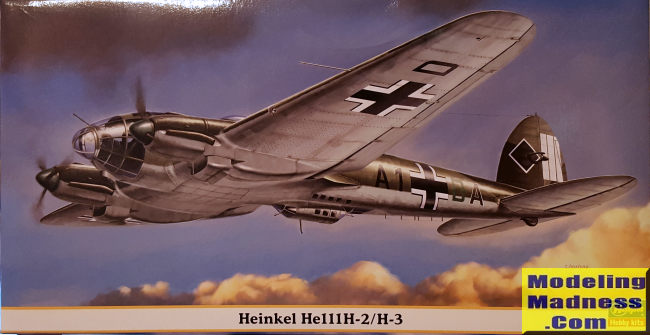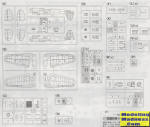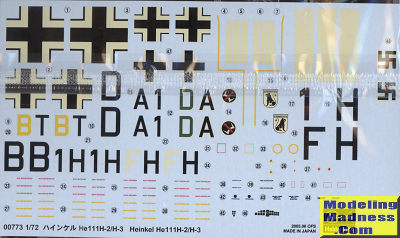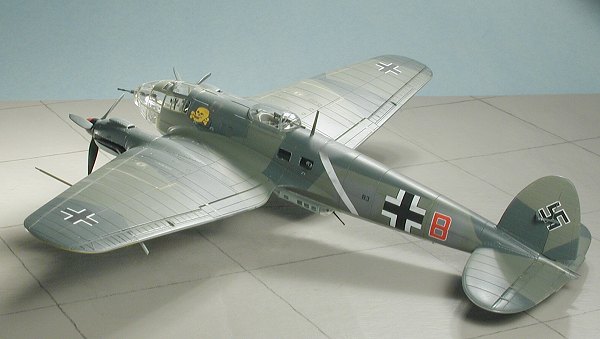
Hasegawa 1/72 He-111H-2/3
| KIT #: | 00773 |
| PRICE: | 3200 yen when new |
| DECALS: | Three options |
| REVIEWER: | Scott Van Aken |
| NOTES: | 2005 Limited Edition |

| HISTORY |
Perhaps the best-recognised German bomber due to the distinctive, extensively glazed "greenhouse" nose of later versions, the Heinkel He 111 was the most numerous Luftwaffe bomber during the early stages of World War II. The bomber fared well until the Battle of Britain, when its weak defensive armament was exposed. Nevertheless, it proved capable of sustaining heavy damage and remaining airborne. As the war progressed, the He 111 was used in a wide variety of roles on every front in the European theatre. It was used as a strategic bomber during the Battle of Britain, a torpedo bomber in the Atlantic and Arctic, and a medium bomber and a transport aircraft on the Western, Eastern, Mediterranean, Middle Eastern, and North African Front theatres.
The H variant of the He 111 series was more widely produced and saw more action during World War II than any other Heinkel variant. Owing to the uncertainty surrounding the delivery and availability of the DB 601 engines, Heinkel switched to 820 kW (1,100 hp) Junkers Jumo 211 powerplants, whose somewhat greater size and weight were regarded as unimportant considerations in a twin-engine design. When the Jumo was fitted to the P model it became the He 111 H. The He 111 H-1 was fitted with a standard set of three 7.92 mm (.312 in) MG 15 machine guns and eight SC 250 250 kg (550 lb) or 32 SC 50 50 kg (110 lb) bombs. The same armament was used in the H-2 which started production in August 1939. The P-series was gradually replaced on the eve of war with the new H-2, powered by improved Jumo 211 A-3 engines of 820 kW (1,100 hp). A count on 2 September 1939 revealed that the Luftwaffe had a total of 787 He 111s in service, with 705 combat ready, including 400 H-1 and H-2s that had been produced in a mere four months. Production of the H-3, powered by the 895 kW (1,200 hp) Jumo 211 D-1, began in October 1939. Experiences during the Polish Campaign led to an increase in defensive armament. MG 15s were fitted whenever possible and the number of machine guns was sometimes increased to seven. The two waist positions received an additional MG 15, and on some variants a belt-fed MG 17 was even installed in the tail. A 20 mm MG FF autocannon would sometimes be installed in the nose or forward gondola.
| THE KIT |
 Though
several companies provided a 1/72 He-111, it was Hasegawa that provided modelers
with the first really modern, modular version of this aircraft. It contains a
fairly complete interior that uses decals for instruments and could benefit from
seat belts. A bomb bay is provided, though little of the interior part of it
will be seen once the kit is built. The tail gear needs to be installed prior to
closing the fuselage halves. As is expected, in various steps of construction,
there are minor modifications that need to be made to parts depending on the
decal option to be used.
Though
several companies provided a 1/72 He-111, it was Hasegawa that provided modelers
with the first really modern, modular version of this aircraft. It contains a
fairly complete interior that uses decals for instruments and could benefit from
seat belts. A bomb bay is provided, though little of the interior part of it
will be seen once the kit is built. The tail gear needs to be installed prior to
closing the fuselage halves. As is expected, in various steps of construction,
there are minor modifications that need to be made to parts depending on the
decal option to be used.
The kit provides the Junkers engine nacelles with polycaps to hold in the props. The flying surfaces are upper and lower with the controls molded in place. Separate wheel wells are provided and installed before cementing the wings together. These fit on short spars that jut from the fuselage at the wing roots. The bomb bay doors can be posed open or closed. If closed, then that provides the option for adding either external bomb racks for large bombs or for torpedoes.
The main landing gear is nicely done and accepts the two piece main wheels. Props are a single piece with separate spinners. Once built, the main gear can be installed, but most will wait until after painting. There are cabin windows that are installed from the outside quite late in the build. Personally, I'd install them before gluing the fuselage halves together so I could be sure of a good fit. Not surprising is that there are a lot of additional bits to add to the nearly complete air frame such as the lower gondola, upper gun position and a variety of antennas and other small bits.
 Instructions
are well done and there are three markings options. All are in 70/71/65 in a
splinter pattern for the upper surface. The box art plane is from KG 53 with
formation stripes on the wing and fin. Another KG 53 plane without these is the
second option, while the third option is a KG 26 aircraft. All are from 1940.
The decal sheet is nicely printed, but old school with the whites actually
off-white. Though these should work well, it would be prudent to have an
aftermarket sheet on standby just in case.
Instructions
are well done and there are three markings options. All are in 70/71/65 in a
splinter pattern for the upper surface. The box art plane is from KG 53 with
formation stripes on the wing and fin. Another KG 53 plane without these is the
second option, while the third option is a KG 26 aircraft. All are from 1940.
The decal sheet is nicely printed, but old school with the whites actually
off-white. Though these should work well, it would be prudent to have an
aftermarket sheet on standby just in case.
| CONCLUSIONS |
I built the base boxing several years ago and was quite pleased with the results. It was somewhat time consuming due to the masking needed and the small bits. It is still the 'go to' kit for this subject in this scale and very much worth picking up. Here is a photo of one I built. This is the H-4 variant using aftermarket decals.

| REFERENCES |
https://en.wikipedia.org/wiki/Heinkel_He_111#He_111_H-1_to_H-10
May 2022 Copyright ModelingMadness.com. All rights reserved. No
reproduction in part or in whole without express permission from the editor. If you would like your product reviewed fairly and fairly quickly, please contact the editor
or see other details in the
Note to
Contributors.